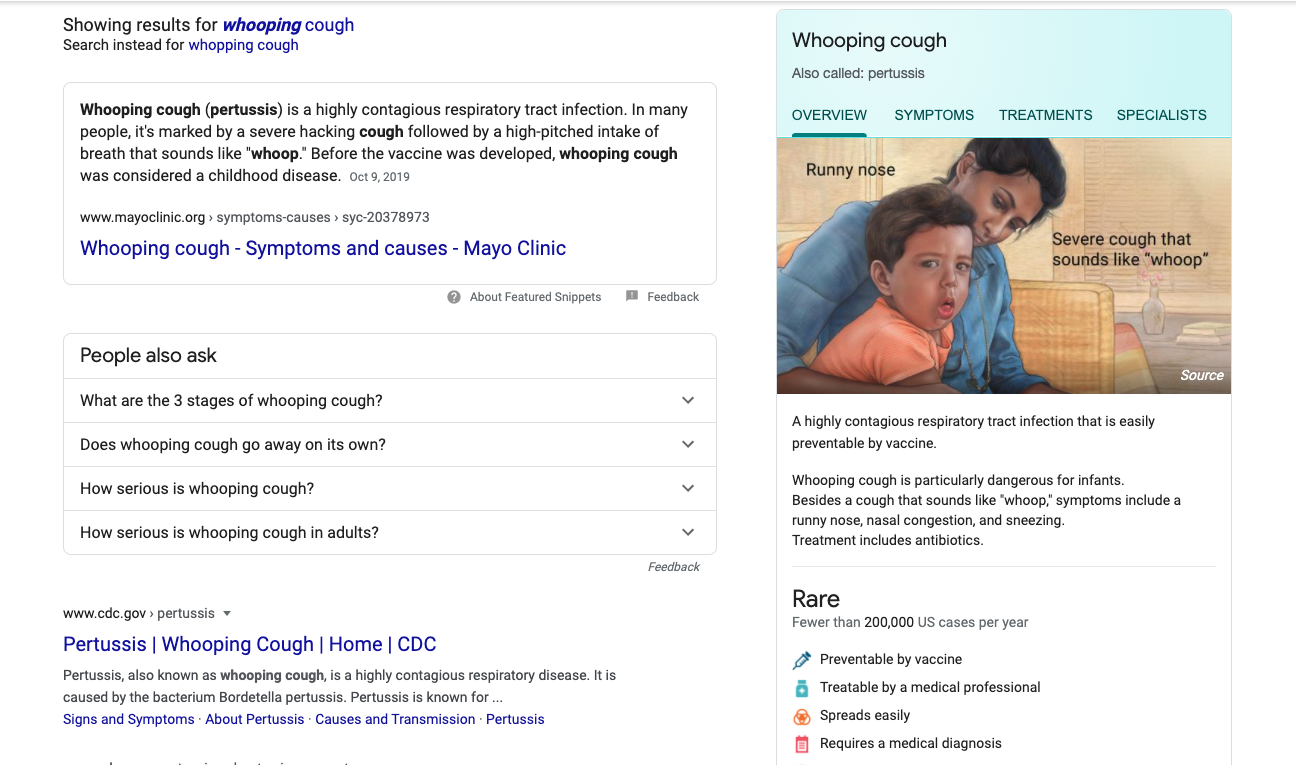This is a guest post by Ben Lund, Founder of Rise Marketing Group, a performance digital advertising agency focused on driving customers and leads through highly customized advertising campaigns.
Think about the last time you were sick or were presented with an unusual health-related symptom. What was the first thing you did? I’m willing to bet it started with a Google search. And this behavior is not uncommon. In fact, this is the first step for most patients before they decide to pick up the phone and give you a call.
A 2012 Compete study found that 77% of patients used search engines for healthcare research. That was more than seven years ago. Now 7% of all Google searches are health-related.
This rapid rise in health queries led Google to update its search engine to ensure answers to users’ most commonly asked questions came from reputable sources. The goal is to give users expert information while avoiding the spread of bad advice from less reputable sites. See sample below for “whooping cough.”
Knowing your patients are actively researching care online, you must ask yourself: Can your patients find information from your practice?
Why your digital presence is important
More and more, patients are beginning their healthcare journey online. I became increasingly aware of this during my time with Google health services from 2014 to 2018.
It helped me realize just how important it was for health systems to be present at key moments during the patient journey. If they’re not, chances are the patient will find another provider. And it makes sense.
Before anyone picks up their phone, the first thing they do is research—even more so for health-related questions. They pore over review sites, look into provider pages, and dig into all the services a health system provides. It’s only when patients feel they’ve exhausted their research that they will make a call.
This is even more evident given the global pandemic. Since the start of COVID, patients have turned to the internet for medical advice. Over 3.9 million searches were conducted in September for worldwide news and information related to the pandemic, according to SEMrush data.
That’s a lot of opportunities to get your healthcare system or practice front and center of your target audience. Not only is it an excellent opportunity to build awareness, but it’s a great way to start establishing a relationship with prospective patients. So, how do you make sure you’re present within the digital patient journey?
Here are four ways to be present within the digital patient journey
As you can imagine, the digital journey is complicated. Prospective patients will search and research on a variety of sites. The healthcare provider’s role is to be present at all stages to share valuable information, which will earn their trust and then earn their business. Here’s a look at approaches healthcare providers should take.
1. Invest in search engine marketing
Make sure you appear in SERPs for relevant searches. Use both paid advertising and optimizing your website to rank higher organically.
When advertising on search engines, don’t just focus on Google. Google has the lion’s share of traffic, but you should also consider Bing to ensure full coverage.
Also consider an SEO strategy to rank for questions prospective patients might be asking. This means you need to level up your content game by providing authoritative and in-depth answers to patient queries.
We have been using CallRail’s Call Tracking and Conversation Intelligence keyword spotting (now autoation rules) to see which keywords and digital ads drive the best leads. This helps us optimize our clients' SEO and content strategies while ensuring we’re only investing in tactics that work.
2. Advertising on relevant health sites
Most digital patient journeys begin on trusted, relevant health sites like WebMD or Healthline.
Partnering with health sites to promote and advertise your healthcare system or practice is a great way to appear where prospective patients are searching. You can use banner ads or contextual targeting on the Google Display Network.
Pro tip: consider content syndication with a health site or publication. Typically, you can work out a packaged deal that allows you to host or sponsor a webinar to generate leads and establish thought leadership about a topic that’s important to your business, along with blogs and banner ad placements for the event.
3. Consider a mobile-first strategy
Health issues are not planned and will appear at any hour and any place. That’s why your strategy should be mobile-first. Speaking from experience, whenever health concerns pop up in our household (i.e., sick children), I'm not usually sitting at my desk in front of a computer. Instead, I turn to my phone to quickly research the condition and find answers.
I’m not alone. Today, 48% of buyers start searches on mobile devices. And mobile search accounts for 48% of call volume. Part of elevating your digital presence along a patient’s journey is providing a frictionless experience, and mobile is the key to accomplishing that goal.
4. Measure, measure, measure
Advertising online can be expensive, but it can also be highly profitable. The primary pillar of any successful and profitable ad campaign is reliable measurement. You must track every conversion, including online forms, and, most importantly, calls driven from advertising.
Because healthcare issues are urgent and complex, prospective patients are more likely to call a provider than submit a lead form. With that in mind, healthcare marketers need an ironclad call measurement approach. At Rise Marketing Group, we use CallRail to track calls driven from our advertising.
Healthcare marketing today
For health systems and practices to grow, they must understand where their prospective patients are to deliver value and accessibility at all points of the patient journey.
Measurement is equally important. Without data, there’s no way to tell if your marketing efforts are working and worth the investment.
Using CallRail, we've been able to give our clients a better view of their customers, their buying journey, and which marketing tactics drive the best results.









